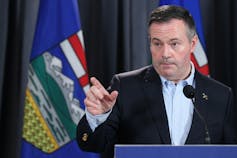Alberta Premier Danielle Smith, while not explicitly advocating for outright independence, continues to promote increased provincial autonomy.
A shift from a theoretical discussion to actively pursuing an independence referendum by Smith or her successors could have dramatic economic consequences for Alberta and Canada similar to the impact separatist movements have had in other parts of the world, including in Spain and the United Kingdom.
In Canada, western alienation has persisted for more than a century, and polls show that 27 per cent of Albertans aged 18 to 34 support the concept of an independent Alberta.
Conventional wisdom holds that Alberta separation is unlikely to ever happen. But the stakes are too high to ignore the possibility of Alberta breaking away.
‘Alberta Agenda’
The Alberta Agenda letter, written in 2001, has influenced Alberta’s approach to federal relations over the last two decades. Among other changes, the letter proposed replacing the Canada Pension Plan with an Alberta Pension Plan and establishing an Alberta police force.
In line with the Alberta Agenda, the provincial government under then-premier Jason Kenney held a referendum in 2021 on the question of whether provisions requiring equalization payments should be eliminated from Canada’s Constitution.

While the majority (61.9 per cent) voted yes, such a Constitutional change cannot be made without support from six other provinces.
Kenney’s referendum did not fully satisfy Alberta separatists and “Freedom Convoy” supporters, two groups that share a number of similarities, leading to an internal party rebellion that resulted in Smith replacing Kenney as premier in 2022.
Smith has kept key elements of the Alberta Agenda front and centre during her first year as premier.
She’s advocating for the Alberta Pension Plan, even though experts have deemed it risky and polls indicate weak support for the proposal.
Nonetheless, it’s likely Alberta separatist groups will keep pressuring Smith to pursue this agenda item — and Smith has suggested she won’t back down. During the provincial election campaign, she vowed to defend Alberta in the face of alleged unfair treatment by Ottawa.
She soon introduced the Alberta Sovereignty Act, which the NDP labelled a step towards separation. Even Kenney criticized its potential to lead Alberta to the brink of separation, which he said would damage the rule of law and the economy.
Similarities to Spain
Canada’s current experience of separatist movements mirrors Spain’s to some extent. Traditionally, the province of Québec in Canada and the Basque region in Spain have been the primary regions pushing for independence.
However, Catalonia’s separatist movement in Spain, which has now surpassed the Basque movement, represents a rapid rise of the kind that could conceivably be seen in Alberta.
In Catalonia, the rise in separatist sentiment was triggered by perceived unfair economic treatment from Spain’s central government.

The Catalan independence movement reached its pinnacle in 2017 when an unauthorized independence referendum was held. The political leaders who participated in it were eventually imprisoned. These events led to significant economic disruption, including a negative impact on the Spanish business environment.
Today, support for Catalonia’s independence has fallen to less than 50 per cent, although the political impact lingers on as two small Catalan separatist parties currently wield signficant influence over Spanish politics.
The decline in Basque separatism and the rise in similar Catalan sentiment in the last two decades may relate to the two regions’ relative economic performance.
The Basque region has experienced strong economic growth, while the fallout from the events of 2017 seems to have dampened Catalonia’s economic prosperity compared to other regions in Spain.
Brexit parallels
The U.K. offers other similarities to the rise of Albertan separatist sentiments.
The Brexit referendum, driven by the U.K. Independence Party and conservative factions under David Cameron, prime minister at the time, was intended to quell separatist sentiments. However, it defied poll predictions, leading to the U.K.’s breakaway from the European Union.

Brexit has been a major factor in the U.K.’s poor economic performance in recent years, and 57 per cent of the British public now want to rejoin the EU.
In the case of both Catalonia and Brexit, it hasn’t just been regional economies that have suffered. The movements also negatively affected Spain and the EU more broadly.
Likewise, even just a referendum on Albertan independence could affect both the Alberta and Canadian economies.
‘No plan’
Former European Council President Donald Tusk famously asked “what that special place in hell looks like for those who promoted Brexit without even a sketch of a plan how to carry it out safely.”
Before ramping up calls for independence, Alberta must rigorously analyze the real costs and time frames of such a momentous undertaking.
An independent Alberta would face numerous challenges, including its landlocked geographical position and heavy reliance on the volatile oil and gas market, which is expected to peak by 2030 before consumption begins to drop significantly.
Additional challenges include restructuring trade relationships, establishing an independent financial system and addressing potential investor dissent.
Read more: What the spectre of Alberta separatism means for Canada
Such a move could also deepen urban-rural divisions, raising questions about the fate of urban voters who prefer to remain in Canada and further complicating issues related to citizens’ rights, mobility and Indigenous opposition.
Catalonia and post-Brexit U.K. illustrate the dangers of radicalization, separatism and divisive rhetoric.
Both the Alberta and federal governments must act to address western alienation and prevent a catastrophic scenario. That requires not just policy adjustments but a commitment to constructive dialogue and inclusive efforts to resolve these issues.

